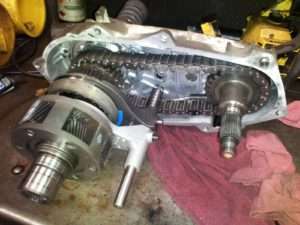If you own a Chevy Silverado, you’d already know that it is important to keep the transfer case control module in good condition. But if you ever found a TCCM (Transfer Case Control Module) that has stopped working, don’t worry! Discover how to reset transfer case control module Silverado in the following article.
That’s because you can reset it yourself, without having to take your truck to a mechanic or wasting your time on an online forum community dedicated to Chevy.
The most effective way to reset the transfer case control module in Silverado is to attach the jumper cables to your vehicle’s batteries after removing the negative terminal wire. You need to follow the right steps, discussed below, to complete the process successfully.
In this article, we’ll walk you through the common causes of improper working of the transfer case control module. Plus, we’ll also explain a step-by-step process of resetting the transfer case control module on a Silverado.
So, if your truck is acting up and you’re not sure what’s wrong, read on for instructions on how to fix it yourself.
Jump to
- 1 Why Does the Transfer Case Module Stop Working?
- 2 Why Do You Need to Reset the Transfer Control Module in the First Place?
- 3 How to Know If the Module Needs to Be Reset?
- 4 How Often Should You Check the Module to Ensure It Is Working Properly?
- 5 What to Do If the Transfer Case Control Module Isn’t Working Properly?
- 6 What Are the Consequences of Not Resetting the Module?
- 7 Final Verdict
Why Does the Transfer Case Module Stop Working?

https://commons.wikimedia.org/wiki/File:NP231PTmSOTF.jpg
Lack of regular maintenance and normal wear and tear are the two most common reasons why a TCCM fails. It’s critically important to read the owner’s manual to find out the frequency of regular service to make sure that your TCCM works properly for a long time.
Other than these two reasons, the following are some other common factors that can lead a TCCM to stop working.
Power Surge
One reason why the module might stop working is because of a power surge. This can happen if there is a power outage or if the battery dies and is replaced. When the power comes back on, it can cause a surge that damages the module.
Wiring Problem
Another reason why the module might stop working is because of a wiring problem. This can happen if the wires that connect the module to the transfer case are loose or damaged.
Water Damage
The transfer case control module can also stop working if it gets wet. This can happen if the truck is driven in the rain or if water somehow gets into the module.
Physical Damage
The module can stop working if it is physically damaged. This can happen if the module is dropped or hit by a heavy object.
Temperature Change
Finally, the module can stop working if it is exposed to extreme temperatures. This can happen if the truck is driven in extremely hot or cold weather.
Why Do You Need to Reset the Transfer Control Module in the First Place?
The primary purpose of the transfer case control module is to control the transfer case, which is the part of the truck that helps to shift gears and adjust the vehicle’s speed.
If the transfer case control module/transmission control module goes out, it can cause the truck to have difficulty shifting gears, or even stall. So, it’s important to keep the module in proper working condition.
Related Article – How to Reset Transfer Case Control Module
How to Know If the Module Needs to Be Reset?
Following are the common signs that tell the module may need to be reset include:
- Check engine light is on: When the module fails, the check engine light will come on. It is a good idea to have a professional service your truck right away.
- 4WD system is not working properly: If the 4WD system is not working, the 4WD light will come on. This is a sign that the module needs to be reset.
- Transfer case is making strange noises: If the module makes a strange noise when you start the truck, then this is another sign that something is wrong.
- Truck is not shifting properly: when the transfer case control module has a defect it might cause the truck to not shift properly.
- Module is getting hot: It is a sign that the module needs to be reset if the module is getting hot to the touch.
- Burning smell coming from the module: The burning smell indicates something wrong with the transfer case control module that needs to be addressed.
- Puddle formation under the location of the transfer case: A bad TCCM can cause a transmission fluid leak that can lead to greasy puddle build-up under the location of the transfer case. Generally, leaks are gradual (even slower in an automatic transmission) but with time your transfer case control module will become dangerously low on oil, which can damage other internal parts.
How Often Should You Check the Module to Ensure It Is Working Properly?
The module should be checked at least once every three months. If you notice any discrepancies, make sure to take your truck to the mechanic so they can properly fix the issue.

https://www.pexels.com/photo/man-fixing-vehicle-engine-2244746/
What to Do If the Transfer Case Control Module Isn’t Working Properly?
If your transfer case control module has stopped working, don’t worry! You can reset it yourself, without needing to take your truck to the mechanic.
Here’s what you’ll need to do:
- Open your vehicle’s hood/bonnet and remove the negative battery cable. Disconnecting the battery is important to prevent any further damage to the module.
- Isolate the battery cable so that it doesn’t come in contact with any other metal parts. You can use a clean rag for this purpose.
- Pick up a jumper cable and attach one of its ends to the positive, and the other end to the negative terminal of the battery.
- Leave the jumper for 5 to 8 minutes to drain all of the charges from all the ECUs.
- After that, remove the rag and jumper cables and install the negative battery cable back in its place.
- Now insert the car key and turn the ignition on for 10 to 15 seconds. Make sure that you keep the key on the “key position 1” and avoid turning on the engine. This will allow the module to reset.
- Next, switch the ignition key off and turn it on again.
- Start the engine and leave it turned on for about 5 minutes. During this time the module will relearn the right values for your Silverado. Don’t turn on any accessories you have in your vehicle as they’ll consume extra power.
- After that, you can start moving your truck to see if the TCCM is working properly.
- If you still notice any irregularity, then repeat this method one more time.
If you follow these steps, you should be able to reset the transfer case control module on your Silverado. This will fix any problems that you’re having with your truck and help to keep it running smoothly.
Another way to reset the TCCM on your Silverado is to turn your truck on and keep acceleration on for a couple of minutes before releasing the gas pedal. You can repeat this process two to three times to reset the module.
After that, leave the engine on for more than 5 minutes so that the system can relearn the values.
You can also remove the transfer case control module fuse located inside the module at the bottom of the fuse box. Then, you’ll need to wait for about 30 to 40 minutes before installing it. It’ll allow the module to reset its values and start working again properly.
Video: https://www.youtube.com/watch?v=_na4Fs1c-Ng&ab_channel=RevitAuto
What Are the Consequences of Not Resetting the Module?
If you don’t reset the module, your truck may have issues with its 4WD system. It could also cause your truck to get stuck in 4WD mode and not be able to shift into 2WD if the TCCM isn’t working properly.
Additionally, a bad transfer case control module could cause your truck to have difficulty shifting gears, or experience other transmission problems. That’s why it’s important to reset the module once every three months.
Final Verdict
The transfer case control module of Silverado might stop working because of different reasons. It includes the check engine light being on, the transfer case making strange noises, the truck not shifting properly, the module getting hot to the touch, a burning smell coming from the module, and the transmission fluid leak under the location of the transfer case.
If any of these signs show up, it is recommended to reset the module. The process of resetting is simple and you can complete it by following the steps mentioned in this guide.
Not resetting the module can lead to many problems including difficulty shifting gears and not being able to shift to 2WD mode from 4WD.
Therefore, you should reset the module on time to avoid any further damage. We hope this article helped explain the importance of resetting the transfer case control module in your Silverado, along with the right method to complete this process.

My name is Tom Harris, founder of this blog. I’m a mechanical engineer with 20 years of experience in the automotive industry. I’m here to help you with your vehicle’s problems, easy fixes and share my insights and experience so that you can enjoy your rides more.

